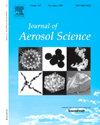微型紫外粒子充电器的性能评价
IF 2.9
3区 环境科学与生态学
Q2 ENGINEERING, CHEMICAL
引用次数: 0
摘要
设计了一种微型紫外气溶胶充电器,并对其充电性能进行了研究。在不同的暴露时间和辐照强度下,使用dmma分类的7至100 nm大小的银(Ag)颗粒评估了迷你紫外气溶胶充电器的性能。测量了不同操作条件下测试粒子的内在和外在充电效率以及电荷分布。实验结果表明,在波长分别为185 nm和254 nm的5 W紫外灯下,当流量为0.3 LPM时,粒子充电性能最佳。测定了氯化钠(NaCl)和二乙基己基塞巴卡特(DEHS)粒子的内在和外在充电效率。最后测量了实验粒子的外在电荷分布。本研究进一步提出了基于Fowler-Nordheim定律(用于计算粒子电荷分布)的光充电模型的改进,考虑了粒子在充电器中停留时间的场分布。本文章由计算机程序翻译,如有差异,请以英文原文为准。
Performance evaluation of a miniature UV particle charger
A mini-UV aerosol charger was designed, and its charging performance was investigated in this work. The performance of a mini-UV aerosol charger was evaluated using DMA-classified silver (Ag) particles in the sizes ranging from 7 to 100 nm under varying exposure times and irradiation intensities. The intrinsic and extrinsic charging efficiencies, and charge distribution of test particles under different operational conditions were measured. It was found that the particle charging with 5 W UV lamps, emitting both wavelengths of 185 and 254 nm, achieved the optimal performance for the charger when operated at a flowrate of 0.3 LPM. The intrinsic and extrinsic charging efficiencies of sodium chloride (NaCl) and Di-Ethyl-Hexyl-Sebacat (DEHS) particles were also measured. The extrinsic charge distribution of test particles was lastly measured. This study further proposed the improvement of the photo-charging model based on the Fowler-Nordheim law (for the calculation of charge distribution of particles) by considering the field distribution of particle residence time in the charger.
求助全文
通过发布文献求助,成功后即可免费获取论文全文。
去求助
来源期刊

Journal of Aerosol Science
环境科学-工程:化工
CiteScore
8.80
自引率
8.90%
发文量
127
审稿时长
35 days
期刊介绍:
Founded in 1970, the Journal of Aerosol Science considers itself the prime vehicle for the publication of original work as well as reviews related to fundamental and applied aerosol research, as well as aerosol instrumentation. Its content is directed at scientists working in engineering disciplines, as well as physics, chemistry, and environmental sciences.
The editors welcome submissions of papers describing recent experimental, numerical, and theoretical research related to the following topics:
1. Fundamental Aerosol Science.
2. Applied Aerosol Science.
3. Instrumentation & Measurement Methods.
 求助内容:
求助内容: 应助结果提醒方式:
应助结果提醒方式:


